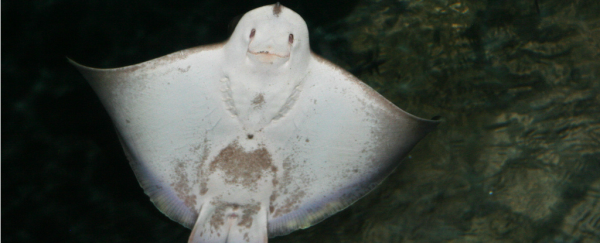Researchers have discovered that a species of stingray from the Amazon River chews its food before swallowing - just like mammals do.
This is the first time that researchers have witnessed a non-mammal actually chewing its food before swallowing it, which makes the ocellate river stingray (Potamotrygon motoro) pretty damn special.
"Complex prey-processing behaviours have been thought to be lacking in fishes and other vertebrates, despite the fact that many of these animals feed on tough prey, like insects or even grasses," reports the team.
After learning that the ocellate river stingray is one of the few species of stingray that commonly eats a tougher diet of insects and shellfish, researchers led by Matthew Kolmann from the University of Toronto in Canada decided to examine how they masticate - a fancy word for "chew" - their food.
They gathered a few stingrays in the lab, and placed them in a special tank with a glass bottom. Then, they fed them a series of foods ranging from soft to hard, and captured the creature's jaw movements on film.
"We investigated prey capture and processing in the insect-feeding freshwater stingray Potamotrygon motoro using high-speed videography. We find that Potamotrygon motoro uses asymmetrical motion of the jaws, effectively chewing, to dismantle insect prey," says the team.
The team found that the stingrays, which can move both their top and bottom jaws at the same time, sucked their food items into their mouths, before chomping down on them at various angles to ensure they were thoroughly masticated.
While this way of chewing is not exactly the same as what we humans do - it features more angles and movement than our jaws allow - the action as a whole resembles the process of mammalian chewing.
"These findings suggest that, in contrast to mammalian chewing, asymmetrical jaw action is sufficient for mastication in other vertebrates," the researchers conclude.
Further investigation using CT scanners also revealed that these stingrays have a series of simple teeth that they use for chewing, much like we do, and that they primarily usher food to their mouths using their fins, instead of gulping with their mouths like fish.
"We also determined that prey capture in these rays occurs through rapid uplift of the pectoral fins, sucking prey beneath the ray's body, thereby dissociating the jaws from a prey capture role," say the researchers.
Having the ability to capture food and chew it up might be an evolutionary trait that has allowed these stingrays to eat a wider variety of foods than other species.
The team says that understanding how chewing and capturing prey work together in non-mammal vertebrates might shed more light on the evolutionary process that led to a similar system in us mammals.
The team's work was published in Proceedings of the Royal Society B.
